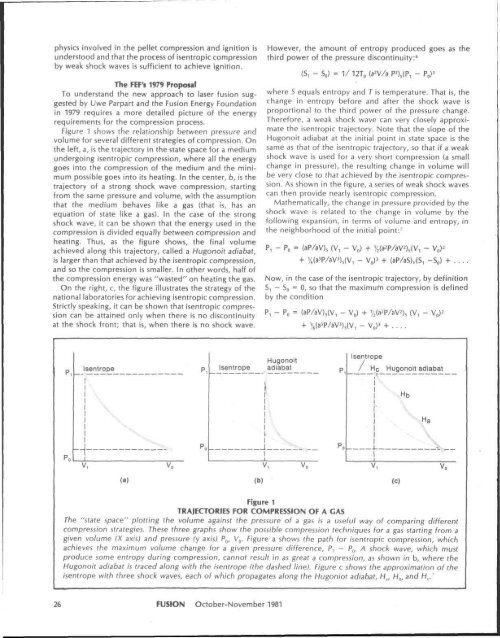Riemann's Contribution to Flight and Laser Fusion
Riemann's Contribution to Flight and Laser Fusion
Riemann's Contribution to Flight and Laser Fusion
- No tags were found...
Create successful ePaper yourself
Turn your PDF publications into a flip-book with our unique Google optimized e-Paper software.
physics involved in the pellet compression <strong>and</strong> ignition isunders<strong>to</strong>od <strong>and</strong> that the process of isentropic compressionby weak shock waves is sufficient <strong>to</strong> achieve ignition.The FEF's 1979 ProposalTo underst<strong>and</strong> the new approach <strong>to</strong> laser fusion suggestedby Uwe Parpart <strong>and</strong> the <strong>Fusion</strong> Energy Foundationin 1979 requires a more detailed picture of the energyrequirements for the compression process.Figure 1 shows the relationship between pressure <strong>and</strong>volume for several different strategies of compression. Onthe left, a, is the trajec<strong>to</strong>ry in the state space for a mediumundergoing isentropic compression, where all the energygoes in<strong>to</strong> the compression of the medium <strong>and</strong> the minimumpossible goes in<strong>to</strong> its heating. In the center, 6, is thetrajec<strong>to</strong>ry of a strong shock wave compression, startingfrom the same pressure <strong>and</strong> volume, with the assumptionthat the medium behaves like a gas (that is, has anequation of state like a gas). In the case of the strongshock wave, it can be shown that the energy used in thecompression is divided equally between compression <strong>and</strong>heating. Thus, as the figure shows, the final volumeachieved along this trajec<strong>to</strong>ry, called a Hugonoit adiabat,is larger than that achieved by the isentropic compression,<strong>and</strong> so the compression is smaller. In other words, half ofthe compression energy was "wasted" on heating the gas.On the right, c, the figure illustrates the strategy of thenational labora<strong>to</strong>ries for achieving isentropic compression.Strictly speaking, it can be shown that isentropic compressioncan be attained only when there is no discontinuityat the shock front; that is, when there is no shock wave.However, the amount of entropy produced goes as thethird power of the pressure discontinuity: 6(S n - So) = 1/ 12T 0 (a 2 Wd P*) S (P, - P 0 )3where S equals entropy <strong>and</strong> T is temperature. That is, thechange in entropy before <strong>and</strong> after the shock wave isproportional <strong>to</strong> the third power of the pressure change.Therefore, a weak shock wave can very closely approximatethe isentropic trajec<strong>to</strong>ry. Note that the slope of theHugonoit adiabat at the initial point in state space is thesame as that of the isentropic trajec<strong>to</strong>ry, so that if a weakshock wave is used for a very short compression (a smallchange in pressure), the resulting change in volume willbe very close <strong>to</strong> that achieved by the isentropic compression.As shown in the figure, a series of weak shock wavescan then provide nearly isentropic compression.Mathematically, the change in pressure provided by theshock wave is related <strong>to</strong> the change in volume by thefollowing expansion, in terms of volume <strong>and</strong> entropy, inthe neighborhood of the initial point: 7P, - P„ = (aP/aV) 5 (V, - V 0 ) + y^P/aV^V, - V 0 H+ y^P/aV^v, - V„)3 + (eP/eSMS, -S 0 ) + ....Now, in the case of the isentropic trajec<strong>to</strong>ry, by definitionS, - S„ = 0, so that the maximum compression is definedby the conditionP, - P 0 = (eP/aV^V, - V 0 ) + %(8'P/aV') 5 (V, - V 0 )'+ yaWaV'MV, - V 0 P + ....Figure 1TRAJECTORIES FOR COMPRESSION OF A GASThe "state space" plotting the volume against the pressure of a gas is a useful way of comparing differentcompression strategies. These three graphs show the possible compression techniques for a gas starting from agiven volume (X axis) <strong>and</strong> pressure (y axis) P 0 , V 0 . Figure a shows the path for isentropic compression, whichachieves the maximum volume change for a given pressure difference, P, - P 0 . A shock wave, which mustproduce some entropy during compression, cannot result in as great a compression, as shown in b, where theHugonoit adiabat is traced along with the isentrope (the dashed line). Figure c shows the approximation of theisentrope with three shock waves, each of which propagates along the Hugoniot adiabat, H a , H b/ <strong>and</strong> H c .'26 FUSION Oc<strong>to</strong>ber-November 1981
















